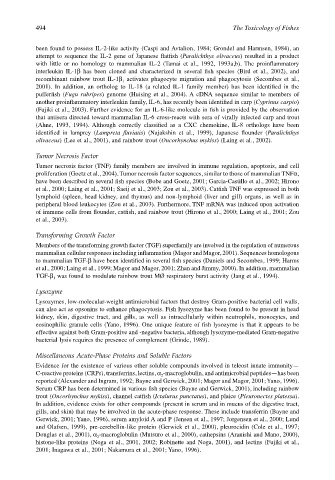Page 514 - The Toxicology of Fishes
P. 514
494 The Toxicology of Fishes
been found to possess IL-2-like activity (Caspi and Avtalion, 1984; Grondel and Harmsen, 1984), an
attempt to sequence the IL-2 gene of Japanese flatfish (Paralichthys olivaceus) resulted in a product
with little or no homology to mammalian IL-2 (Tamai et al., 1992, 1993a,b). The proinflammatory
interleukin IL-1β has been cloned and characterized in several fish species (Bird et al., 2002), and
recombinant rainbow trout IL-1β activates phagocyte migration and phagocytosis (Secombes et al.,
1
2001). In addition, an ortholog to IL-18 (a related IL-1 family member) has been identified in the
pufferfish (Fugu rubripes) genome (Huising et al., 2004). A cDNA sequence similar to members of
another proinflammatory interleukin family, IL-6, has recently been identified in carp (Cyprinus carpio)
(Fujiki et al., 2003). Further evidence for an IL-6-like molecule in fish is provided by the observation
that antisera directed toward mammalian IL-6 cross-reacts with sera of virally infected carp and trout
(Ahne, 1993, 1994). Although correctly classified as a CXC chemokine, IL-8 orthologs have been
identified in lamprey (Lampreta fluviatis) (Najakshin et al., 1999), Japanese flounder (Paralichthys
olivaceus) (Lee et al., 2001), and rainbow trout (Oncorhynchus mykiss) (Laing et al., 2002).
Tumor Necrosis Factor
Tumor necrosis factor (TNF) family members are involved in immune regulation, apoptosis, and cell
proliferation (Goetz et al., 2004). Tumor necrosis factor sequences, similar to those of mammalian TNFα,
have been described in several fish species (Bobe and Goetz, 2001; Garcia-Castillo et al., 2002; Hirono
et al., 2000; Laing et al., 2001; Saeij et al., 2003; Zou et al., 2003). Catfish TNF was expressed in both
lymphoid (spleen, head kidney, and thymus) and non-lymphoid (liver and gill) organs, as well as in
peripheral blood leukocytes (Zou et al., 2003). Furthermore, TNF mRNA was induced upon activation
of immune cells from flounder, catfish, and rainbow trout (Hirono et al., 2000; Laing et al., 2001; Zou
et al., 2003).
Transforming Growth Factor
Members of the transforming growth factor (TGF) superfamily are involved in the regulation of numerous
mammalian cellular responses including inflammation (Magor and Magor, 2001). Sequences homologous
to mammalian TGF-β have been identified in several fish species (Daniels and Secombes, 1999; Harms
et al., 2000; Laing et al., 1999; Magor and Magor, 2001; Zhan and Jimmy, 2000). In addition, mammalian
TGF-β was found to modulate rainbow trout MØ respiratory burst activity (Jang et al., 1994).
1
Lysozyme
Lysozymes, low-molecular-weight antimicrobial factors that destroy Gram-positive bacterial cell walls,
can also act as opsonins to enhance phagocytosis. Fish lysozyme has been found to be present in head
kidney, skin, digestive tract, and gills, as well as intracellularly within neutrophils, monocytes, and
eosinophilic granule cells (Yano, 1996). One unique feature of fish lysozyme is that it appears to be
effective against both Gram-positive and -negative bacteria, although lysozyme-mediated Gram-negative
bacterial lysis requires the presence of complement (Grinde, 1989).
Miscellaneous Acute-Phase Proteins and Soluble Factors
Evidence for the existence of various other soluble compounds involved in teleost innate immunity—
C-reactive proteins (CRPs), transferrins, lectins, α -macroglobulin, and antimicrobial peptides—has been
2
reported (Alexander and Ingram, 1992; Bayne and Gerwick, 2001; Magor and Magor, 2001; Yano, 1996).
Serum CRP has been determined in various fish species (Bayne and Gerwick, 2001), including rainbow
trout (Oncorhynchus mykiss), channel catfish (Ictalurus punctatus), and plaice (Pleuronectes platessa).
In addition, evidence exists for other compounds (present in serum and in mucus of the digestive tract,
gills, and skin) that may be involved in the acute-phase response. These include transferrin (Bayne and
Gerwick, 2001; Yano, 1996), serum amyloid A and P (Jensen et al., 1997; Jorgensen et al., 2000; Lund
and Olafsen, 1999), pre-cerebellin-like protein (Gerwick et al., 2000), pleurocidin (Cole et al., 1997;
Douglas et al., 2001), α -macroglobulin (Mutsuro et al., 2000), cathepsins (Aranishi and Mano, 2000),
2
histone-like proteins (Noga et al., 2001, 2002; Robinette and Noga, 2001), and lectins (Fujiki et al.,
2001; Inagawa et al., 2001; Nakamura et al., 2001; Yano, 1996).

